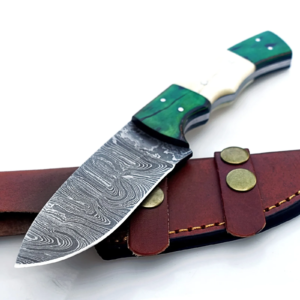Handmade 39″ Scottish Claymore Sword – William Wallace Braveheart – Stainless Steel Blade with Leather Sheath. Medieval King Arthur Inspired – Rat-Tail Tang – USA. Native American Tribes Cherokee, Iroquois, and Choctaw – Scottish Claymore, Romans, Samurai, Scimitar

Step into History with the 39″ William Wallace-Inspired Scottish Claymore Sword
Feel the might of a legendary hand-forged 39″ Handmade Scottish Claymore Sword inspired by the heroic figure William Wallace from the movie Braveheart. Made from stainless steel with an immortal spirit of Scottish warriors, this sword comes with a sleek leather sheath for safe storing and comfortable carrying.
Own a Battle-Ready William Wallace Claymore – Perfect for Collectors and Cosplayers
It features a rat-tail tang design for additional strength. This medieval design sword is ideal for the history buff or any who would be warriors in their own right. It provicdes a feeling of reaching back to the mythical times of King Arthur. Elegant in its craftsmanship, it’s a beautiful display piece, while solid in its construction makes it battle-ready for reenactments or cosplayers alike. Whether you’re adding to a collection of swords or seeking the perfect gift for someone who loves history, this William Wallace-inspired Claymore is not to disappoint. Order yours today and own a piece of history!
The essance of the Scottish Claymore Sword
The Scottish Claymore has long been identified with Scottish history, a symbol of strength and freedom, resistance against tyranny. Its iconic design became famous in the 13th century, wielded by Scottish warriors in a host of battles for independence. This replica brings into reality the spirit of William Wallace and Robert the Bruce, two legendary figures who stood for freedom against tyranny. It is because of all these historical figures and many more that the Scottish Claymore was handmade and prepared for, according to the historical importance of the sword.
Craftsmanship and Materials
This hand-forged Scottish Claymore combines strength, durability, rust resistance, and tarnish resistance, thanks to its premium stainless steel construction. The 39″ length balances agility with power, really offering the best of both worlds for any collector or enthusiast. A rat-tail tang adds strength and balance to this weapon, functional and not merely decorative for actual use in battle reenactments or cosplaying. Paired with a great leather sheath, this sword was perfectly designed with history in mind and wields the ability of a modern-day craftsman.
King Arthur’s Influence on Sword Design
This is decidedly a Scottish sword, but even in its design, it retains much of the mythological swords from the time of King Arthur, another major influence on medieval European weaponry. Just as King Arthur’s Excalibur symbolized kingship and chivalry, the Scottish Claymore symbolized resistance and liberty. This sword will be an exciting addition to any medieval sword collector or enthusiast of Arthurian lore for the workmanship and historical overtones it brings with it.
Native American Weaponry and European Influences
Although most Native American tribes had tools such as tomahawks, spears, and bows, the inclusion of metal swords came with European settlers into their societies. For example, tribes like the Cherokee, Iroquois, and Choctaw encountered. Sometimes adopted European-style swords for ceremonial purposes or as some sort of status symbol amongst leaders. In fact, these swords, often traded or gifted by European settlers. Hence, these became part of evolving Native American weaponry post-contact. Moreover, certain warriors, especially those from tribes allied with European powers, took these swords into battle. Thus melding the traditional Native American craftsmanship with European weaponry. Notably, the Cherokee and the Creek people were among those tribes that adapted European weapons as tools of war. They used these swords during periods of conflict.
Ancient Civilizations and Their Swords
Beyond Native American tribes, many other great civilizations have formed their hallmark swords, comparable to the Scottish Claymore. For instance, the Romans famously used the Gladius, a short sword that helped them dominate much of the ancient world. Similarly, in Japan, the Katana became the weapon of choice for the Samurai, an object of both honor and discipline. Likewise, in Persia, the Scimitar was used both for battle and ceremonial purposes. Much like the Scottish Claymore, each of these swords held immense cultural and historical meaning to its respective owners. It often reflected a great civilization’s values and influence.










Reviews
There are no reviews yet.